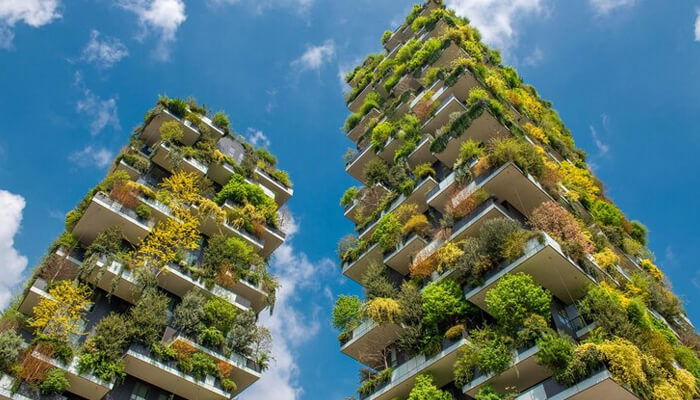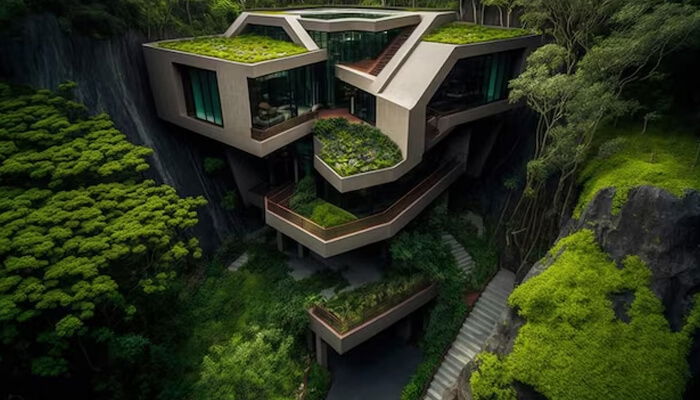Architecture and Design are said to have a major impact on the environment. Architects have been reshaping today’s built environment so as to benefit people and the planet alike. Global warming is already showing signs of climatic changes across the globe. Hence, humanity has only a decade or even less time to reduce its impact. The current architecture industry is compelled to re-evaluate how it works. To reduce pressure upon this beautiful planet, architects are doing their best to optimize urban greenery, collaborate as well as lobby change, and derive viable solutions.
Top 10 Eco-friendly Interior design Adopted in 2023
1. Going carbon-neutral:
For many architects, creating carbon-negative or carbon-natural architecture is a major concern. Net carbon-neutral buildings can be termed to be one that does not add carbon dioxide into the atmosphere during their lifetime. Also, its construction, construction materials used, and resources necessary to run/decommission it. Besides this, more carbon is eliminated from the atmosphere than what is emitted over its lifetime.
2. Construction with timber:
Throughout history, wood has been the favorite building material. Improvements made in engineered timbers like CLT (cross-laminated timber) combined with sustainability credentials have helped it regain its popularity in constructing residential houses. It sequesters carbon from the atmosphere in huge amounts and stores it inside the building, thus achieving carbon-negative objectives.
3. Passivhaus Standards:
Passivhaus performance standards are considered as latest technologies to be used to develop sustainable architecture. Passivhaus Trust, a non-profit organization has established this standard to promote buildings having air tightness and maximum insulation levels. This way, it will need minimal artificial cooling and heating.
4. Rewilding:
In recent times, Rewilding seems to have made people realize the fast disappearance of natural ecosystems. They have understood the need for Networking biodiversity with buildings to support life. This approach assures restoring ecosystems allowing nature to work itself without much human interference. Architects can consider biodiversity both while choosing materials and landscaping projects.
5. Non-extractive architecture:
Space Caviar, an Italian research studio had coined this term. The objective is to express ideas of developing buildings that do not exploit people or the planet. The idea is to ensure architects start Networking and designing buildings that take care of natural resources and not deplete them.
6. Reversible design:
This type of architecture is supported to ensure that buildings as a whole is destructed during their end stage. Also, all its components are reused and not wasted. According to experts, every building can be termed to be a DIY store meant to support the next project.
7. Restorative architecture:
It is also referred to as regenerative architecture. It means structures creative positive impact upon the environment. Architects will able to tackle different types of environmental challenges faced today. The belief is that architecture mitigates negatives and uses the latest technologies to construct nature-friendly buildings.
8. Biomimicry:
Using biomimicry can help architecture combat climate change. This technique tends to emulate natural systems like coral reefs. It might result in an extremely efficient structure reduce material usage and replicate beneficial processes.
9. Set up climate action groups:
It is necessary for architects to address the impact made by the built environment upon the planet. Proper initiatives need to be taken at the grassroots level like forming climate action groups. It can help share valuable knowledge on climate change and raise awareness and boost Eco-friendly interior design.
10. Retrofitting:
It means upgrading and working to enhance a building’s thermal performance and energy efficiency. It also reduces dependency upon cooling and heating or updates a structure that otherwise could be torn down.
Protect nature with eco-friendly designs
Architecture and Design can support nature and promote the overall well-being of people and the planet alike. As highlighted in recent architecture news, the above techniques should be used to achieve the end objective.



